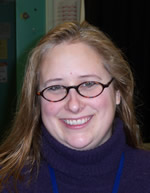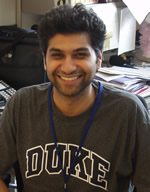Last updated: May 13, 2014
NHGRI supports seven young investigators on research career paths
Pathway to Independence Awards
NHGRI supports seven young investigators on research career paths
Raymond MacDougall
Associate Communications Director for Intramural Research
 |
"I am pleased that several of our intramural program trainees were selected for Pathway to Independence Awards, which will help each of them set their course for promising research careers," said NHGRI Scientific Director Dan Kastner, M.D., Ph.D. "The NHGRI intramural program offers exceptional training opportunities. An award of this distinction is a fantastic launching point into the field."
Elizabeth Grice, Ph.D., Katherine Hyde, Ph.D., Praveen Sethupathy, Ph.D., and Michael Stitzel, Ph.D., are NHGRI intramural program recipients of this year's competitive awards, also called K99/R00s. The awards combine two, uninterrupted phases of support over five years, providing early career scientific leaders a strong foundation for independent research.
In addition to the intramural recipients, the NHGRI Division of Extramural Research recently named the following recipients:
Barbara Engelhardt, Ph.D.,computer science, University of Chicago Department of Human Genetics and Statistics. Her project is titled, "Statistical models to investigate long-distance QTL transcription regulation."
Jinchuan Xing, Ph.D., biochemistry, Eccles Institute of Human Genetics, University of Utah. Dr. Xing's project is titled, "High-throughput mobile element genotyping using next-generation sequencing."
Michael Hoffman, Ph.D., biology, University of Washington. His project is titled, "Pattern discovery for comparative Epigenomics."
The initial, two-year component of the award - the Scholar Development Phase (or K99) - provides support for supervised research work. A subsequent award period - the Faculty Transition Phase (or R00) - lasts up to three years and provides support for the grantee as an independent tenure-track or equivalent researcher. During the R00 phase of support, grantees establish research independence, publish their results and are expected to apply for grant support via an NIH Research Project grant (R01).
For each Pathway to Independence Award recipient, the program facilitates the transition from mentored postdoctoral research status to a stable, independent research position, hopefully faster than the norm. The program also aims to help NIH increase and maintain a strong team of biomedical investigators.
Review of Pathway to Independence applications are accepted on the 12th day of the month in February, June and October of each year. Trainees at universities and in the NIH intramural program are eligible. For more information, please visit http://grants.nih.gov/grants/guide/contacts/parent_K99_R00.html.
Here are the stories of each Pathway to Independence awardee from the NHGRI intramural program.
Elizabeth Grice, Ph.D.
 |
"At the time, very little was known about the microbiota colonizing our bodies and especially about skin microbiota," she said. "I was fascinated and immediately knew I wanted to do a post-doc with Dr. Segre."
Dr. Grice's achieved her goal and she can look back now at a five-year, multi-disciplinary training period in Dr. Segre's laboratory. "I found myself training in a lot of areas such as microbiology, immunology and dermatology," she said. The five-year stint at NIH included a three-year fellowship award from the National Institute of General Medical Sciences Pharmacology Research Associate Program and two years as a postdoctoral Intramural Research Training Awards, or IRTA.
In Dr. Segre's lab, Dr. Grice used genomics to characterize the colonies of microbes inhabiting healthy human skin. Descriptions of the beneficial populations of microbes were then compared to changes in microbial communities that contribute to skin disorders. She soon became interested in skin wound healing and how microbes impair healing in conditions such as diabetes or in areas of the body where blood flow is insufficient.
According to Dr. Grice, chronic, non-healing wounds are a major health care burden, causing disability and decreased quality of life. They are associated with prolonged hospitalizations, antibiotic exposure, pain and restricted mobility. A significant number of patients may even require amputations. Better treatment options are needed for chronic wounds, which are the single most expensive skin disorder.
Antibiotics are often used to treat chronic wounds but are not always effective and can actually pose a threat due to multi-drug resistant bacteria, Dr. Grice said. Her research uses a mouse model of impaired wound healing that helps illustrate the mechanism by which microbes impair wound healing.
"I am particularly interested in relationships between microbes and the innate immune response in chronic wounds," Dr. Grice said. With collaborators, she has started to characterize microbial populations in human diabetic ulcers. The goal of this work is to correlate clinical phenotypes - descriptions of disease - with patterns of microbial colonization over time.
Dr. Grice credits the NIH Pathway to Independence award program with providing grant-writing experience and helping to shape her independent research program. As the upcoming new year begins, she will start a tenure track position in the Department of Dermatology at the University of Pennsylvania, during which her K99 portion of the Pathway to Independence Award will be funded by the National Institute of Arthritis and Musculoskeletal and Skin Diseases. She'll be departing NHGRI with gratitude for the valuable mentoring she received.
"Having mentors and role models has been a key part of my success," she said. "I pictured myself in the same roles as my mentors. These experiences make me realize that my future role as a mentor is very important, especially in encouraging young women to seek careers in science."
Dr. Grice aspires not just to achieve tenure, but to conduct research that will significantly impact the way chronic wounds are treated. Her long-term goal is to be a department chair in order to shape the direction of a research program.
Katherine Hyde, Ph.D.
 |
While pursuing her Ph.D., Dr. Hyde focused on the developmental aspects of cell-cycle control. She became motivated to work on an aspect of leukemia research during graduate school, when her father died from the blood disease.
"From early in my research career, I've been interested in studying how a cell knows when to divide, how that is controlled during development and how it gets out of control in cancer," she said.
In 2005, she began working as a postdoctoral fellow and later as a research fellow in the lab of Paul Liu, M.D., Ph.D., NHGRI Division of Intramural Research deputy director and senior investigator in the Genetics and Molecular Biology Branch. Dr. Liu is a world expert in the onset, development and progression of leukemia. As an NHGRI postdoctoral fellow and later as a research fellow, she studied a family of genes both in normal development and leukemia. Her project on normal development didn't pan out, but the alternate project on leukemia took off.
"That is one of the things that I liked so much about Paul Liu's research; he studies both," she said. "I consider my field to be hematopoiesis and leukemia with particular focus on the leukemia stem cell, which is able to propagate the disease." Hematopoiesis refers to the formation of blood cells in the body's blood-forming tissues, particularly the bone marrow and lymphatic tissue.
Unfortunately, leukemia stem cells can be difficult to kill with current treatments, which may be the reason so many patients with leukemia relapse. As a member of Dr. Liu's team, Dr. Hyde uses a mouse model of a specific subtype of acute myeloid leukemia that is caused by an inversion on chromosome 16, which is an end-to-end rearrangement of a segment of the chromosome. Dr. Hyde used this mouse model to develop a way to isolate leukemia stem cells. Her future research will focus on characterizing these leukemia stem cells and trying to figure out ways to better target them with new drugs.
"Dr. Liu is generously allowing me to bring my project with me when I start my own lab," Dr. Hyde said. Her NIH Pathway to Independence Award is relatively recent, so she is just beginning her job search.
Dr. Hyde says that working with mentors who each have a different style has given her a chance to see a variety of ways to run a lab and work with students and post-docs. At NIH, she has had the opportunity to develop her own style and has already mentored several students.
"Writing the K99 was a really good experience," she said about preparing a proposal for the award portion that will be funded by the National Cancer Institute. "It forced me to think about my project and where I wanted it to go in the long term, and not just what the next experiment should be." She looks forward to building a strong independent research program and making important contributions to the leukemia field.
"I've really enjoyed being at NIH," she said. "I've gotten great research opportunities and lots of support from people throughout NHGRI. Plus, I've really appreciated the research independence Dr. Liu has given me."
Praveen Sethupathy, Ph.D.
 |
"At the time, the human genome project was gaining steam, ushering in a new era of high-throughput biological discovery," he recalled. With the advent of so much data to analyze, computational genomics seemed like a natural and exciting fit for his skills and interests.
During his Ph.D. program at the University of Pennsylvania in the field of genomics and computational biology, Dr. Sethupathy received multi-disciplinary training in areas such as bioinformatics, molecular biology and statistics. In his thesis project, he applied large-scale genomic approaches to understand gene regulation, which refers to how genes are turned on, off or are finely adjusted.
Eager to apply his training and knowledge to a medically relevant arena, Dr. Sethupathy joined the lab of Francis Collins, M.D., Ph.D., then NHGRI director and now NIH director. For the past three years, while a postdoctoral fellow, Dr. Sethupathy has focused on using experimental and computational genomic strategies to investigate the role of gene regulation in complex human diseases, such as type 2 diabetes.
"Although every cell in the body contains the same instruction booklet,or genome, different types of cells execute different sets of instructions, or genes. This is what allows a heart cell to behave differently than a neuron, which behaves differently than a skin cell, and so on," he said. "Which genes are activated, or expressed, and the extent to which they are activated, is referred to as gene regulation and is a key determinant of a cell's function."
His research investigates the various strategies that a cell uses to control gene expression, and how these might differ between a normally functioning cell and a disease-predisposed cell. The description gets a bit more complicated with additional details involving the structure of DNA and how it affects gene regulation.
"The majority of the genome does not encode for genes," Dr. Sethupathy explains. "Rather, it contains DNA regulatory elements that are involved in controlling whether and how much a gene is expressed."
Scientists don't yet know precisely how many regulatory elements there are or where they reside in the genome. Recently, advances in the field of gene regulation have revealed that the way the genome is packaged in the cell might hold some important clues. Specifically, the packaging material of DNA, called chromatin, can carry different types of marks that denote different types of regulatory elements.
Dr. Sethupathy and a colleague in the Collins lab co-led an effort to use large-scale experimental and computational genomic methods to profile the chromatin marks throughout the genome of pancreatic islet cells, which play a key role in the development of type 2 diabetes. The pair discovered thousands of novel regulatory elements and found evidence that several of these are directly affected by genetic variants, or mutations, that have spread in the population and are known to increase risk for type 2 diabetes.
Dr. Sethupathy also studies another important class of regulatory elements, called microRNAs. These elements are very small RNA molecules which, like DNA regulatory elements, are involved in controlling gene expression.
"In the last decade or so, it has become clear that microRNA malfunctions could lead to various human diseases," he said. "I am interested in assessing the role of microRNAs in the etiology of type 2 diabetes and related metabolic disorders, and whether they can be pursued as novel therapeutic targets."
"The K99/R00 and similar faculty-transition awards are extremely valuable programs for senior postdoctoral fellows," he said. "I found that obtaining a K99/R00 grant can be quite helpful as a validation to employers and collaborators of one's scientific ideas and as a marker of one's future ability to write successful grant proposals." The K99 portion of Dr. Sethupathy's award will be supported by the National Institute of Diabetes and Digestive and Kidney Diseases (NIDDK).
This past September, Dr. Sethupathy accepted a position as assistant professor in the Department of Genetics at the University of North Carolina at Chapel Hill. He hopes to be actively involved in mentoring students and post-docs in the early stages of their careers, to run a productive genomics laboratory, and to eventually take on leadership positions at the university to push forward scientific innovation and education.
Michael Stitzel, Ph.D.
 |
"During my undergraduate years, I was a total lab rat, setting up experiments between classes and before football games," Dr. Stitzel recalls. The reward of discovery came early when he found a role for the proteosome-which he likens to the cell's garbage disposal-in regulating cellular stress response pathways in yeast.
Dr. Stitzel identified a post-baccalaureate research experience after a two-week European singing tour with the Penn State Concert Choir. "I was convinced that I needed to spend some time in Germany even if it meant deferring my admission into the Johns Hopkins School of Medicine," he said. A year-long Fulbright fellowship at the University of Heidelberg Center for Molecular Biology gave him the opportunity to study the role of DNA methylation on gene expression and development in the common fruit fly.
Dr. Stitzel subsequently entered the human genetics program at Johns Hopkins School of Medicine, becoming intrigued by the emerging field of functional genomics and the genetic basis of human health and disease. "This area of research is evolving quickly," he said.
During his five-year postdoctoral research fellowship in NHGRI's Molecular Genetics Section with NIH Director Francis Collins, M.D., Ph.D., Dr. Stitzel was exposed to various advanced genomic research methods, from genome-wide epigenetic profiling (that considers changes in DNA function that don't involve the DNA sequence), genome-wide association studies (that identify genetic variants by scanning the entire genomes of different people who may share a disease trait), and cellular reprogramming with induced pluripotent stem cells (that involves cells that are not yet differentiated so have potential to be determined). "All of these methods were emerging as I joined the lab," he said. "Combined, they provide powerful opportunities to crack some of the mysteries of human variation and predisposition to disease. I'm banking on that."
Dr. Stitzel's current research focuses on understanding how genetic variation in non-coding, regulatory regions of the human genome contribute both to an amazing diversity among people and to genetic susceptibility to disease. He studies how DNA changes that are statistically associated with genetic susceptibility to type 2 diabetes may lead to altered function of the key blood sugar-sensing and insulin-secreting cells in the islets of Langerhans in the pancreas.
"My initial goal in the lab was to identify all possible regulatory regions and elements used by human pancreatic islets," he said. He recently co-led a study, published in the journal Cell Metabolism, on this research topic.
His next set of research goals include:
- Understanding how and when human islet regulatory regions are used under different physiologic stimulus or stress conditions, to which cells act according to a variety of protective responses.
- Assessing how our personal genomes and catalogue of genetic differences - especially those statistically linked to diabetes susceptibility - alter those responses.
- Developing an induced pluripotent stem cell approach to identify regulatory elements used at different developmental steps on the way to making islet cells.
- Determining how genetic variants alter the use of these regulatory elements in these developmental, precursor cells.
Dr. Stitzel recognizes that advancement in his research career will depend on building skills in grant writing, publishing, communicating science in plain language to the public, managing personnel and even assessing his own personality type and management style. "When I talk with friends and colleagues at the next level, I don't hear about difficulties pipetting, but rather issues with securing grants and funding, budgeting lab operations and managing projects, staff and students," he said.
Next fall, Dr. Stitzel will pursue a tenure track position and will put the NIH Intramural Program at the top of his prospect list. He will also look at opportunities at large academic research and medical institutions with the infrastructure and resources that could support his work.
"The work I've been doing is very collaborative and requires additional expertise of good colleagues to fully realize its potential," he said. "I've been lucky to find that during my postdoctoral fellowship, and I hope to keep those strong ties."
Dr. Stitzel's K99 project, reviewed and awarded by NIDDK, began this past August. "Earning a K99 has been my strategic goal to jump-starting my career since day one of my post-doc," Dr. Stitzel said. "It has helped me to focus my interests and goals tremendously and served as a valuable external validation that peers in my field think these questions are important and that the experimental approaches to answer these questions are sound."
